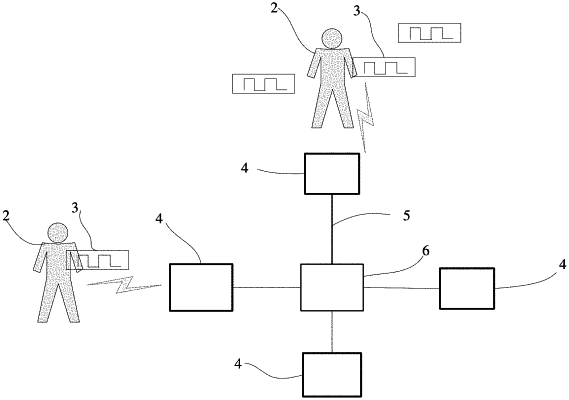| CPC G06V 20/58 (2022.01) [G06K 7/10475 (2013.01); G06K 19/0724 (2013.01); G06K 19/07773 (2013.01); G06N 3/04 (2013.01); G06N 3/08 (2013.01); G06K 2019/06253 (2013.01)] | 20 Claims |

|
1. A system for calculating a regional crowd movement applied to a target monitoring environment, comprising:
a plurality of key travel nodes disposed within the target monitoring environment, radio frequency labels configured to be deployed on pedestrians, calculation apparatuses deployed at the key travel nodes, and
a plurality of directional antennas, wherein
the directional antenna is configured to, when driven by the calculation apparatus, send a read-write signal to the radio frequency label in a coverage region;
the radio frequency label is configured to reflect a radio frequency signal upon obtaining the read-write signal to the directional antenna;
the directional antenna is configured to forward the radio frequency signal to the calculation apparatus;
the calculation apparatus is configured to, based on a tempo-spatial distribution circumstance of the radio frequency signals in the region, adaptively calculate a regional crowd movement trend using a trained deep learning model;
the directional antenna is configured to read the radio frequency labels such that a count of the radio frequency labels accurately read in one second is greater than or equal to 200 pieces(PCS);
the trained deep learning model comprises multiple layers of neural networks;
the multiple layers comprise an input layer for obtaining the input data, an intermediate layer for performing nonlinear mapping for the input data, and a sequence layer for performing time accumulation updating and nonlinear mapping;
the input layer comprises 8 neurons with a corresponding input sequence being [D(0), D(1), D(2), D(3), rssi(0), rssi(1), rssi(2), rssi(3)], where D(0) indicates whether or not a first directional antenna of the plurality of directional antennas received the radio frequency signal, D(1) indicates whether or not a second directional antenna of the plurality of directional antennas received the radio frequency signal, D(2) indicates whether or not a third directional antenna of the plurality of directional antennas received the radio frequency signal, D(3) indicates whether or not a fourth directional antenna of the plurality of directional antennas received the radio frequency signal, rssi(0) comprises a first signal strength of the radio frequency signal received by the first directional antenna, rssi(1) comprises a second signal strength of the radio frequency signal received by the second directional antenna, rssi(2) comprises a third signal strength of the radio frequency signal received by the third directional antenna, and rssi(3) comprises a fourth signal strength of the radio frequency signal received by the fourth directional antenna;
the intermediate layer is configured to perform numerical nonlinear mapping using an activation sigmoid function;
the sequence layer comprises two layers of neuron sequences;
where a longitudinally-connected neuron sequence is used to perform the nonlinear mapping and a horizontally-connected neuron sequence is used to perform the time accumulation updating;
data of the sequence layer is updated rightward by one column when data of the input layer is updated once;
the multiple layers further comprise a fully-connected layer and an output layer;
where an output sequence corresponding to the output layer comprises [C(0), C(1), C(2), C(3), C(4), C(5), C(6), C(7)], respectively corresponding to movement probabilities of current input layer data among the first directional antenna, the second directional antenna, the third directional antenna, and the fourth directional antenna; and
C(0) represents a first movement probability that a pedestrian of the pedestrians moves from a first region covered by the first directional antenna to a second region covered by the second directional antenna, C(1) represents a second movement probability that the pedestrian moves from the second region covered by the second directional antenna to the first region covered by the first directional antenna, C(2) represents a third movement probability that the pedestrian moves from the second region covered by the second directional antenna to a third region covered by the third directional antenna, C(3) represents a fourth movement probability that the pedestrian moves from the third region covered by the third directional antenna to the second region covered by the second directional antenna, C(4) represents a fifth movement probability that the pedestrian moves from the third region covered by the third directional antenna to a fourth region covered by the fourth directional antenna, C(5) represents a sixth movement probability that the pedestrian moves from the fourth region covered by the fourth directional antenna to the third region covered by the third directional antenna, C(6) represents a seventh movement probability that the pedestrian moves from the fourth region covered by the fourth directional antenna to the first region covered by the first directional antenna, and C(7) represents an eighth movement probability that the pedestrian moves from the first region covered by the first directional antenna to the fourth region covered by the fourth directional antenna.
|